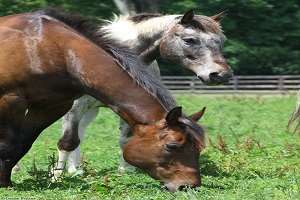There’s no doubt that horses learn a lot from humans. But there are also times when horses clearly learn from each other. Younger horses, in particular, are full of spunk, but older horses are usually around to keep them in line and to demonstrate the proper behavior.

Sometimes on fresh, windy days I watch young horses—who are clearly in the mood to play—bounce around the older horses in an attempt to get them riled up too. The young horses snort, blow, spook at nothing, and then try to take off running, hoping to get the whole pasture in on the action. "Come on! Let’s pretend to be scared of the wind! Let’s RUN!” Occasionally, the more mature horses give in and run the fencelines for a few minutes, much to the youngsters’ fun-loving delight. But more often than not, the older horses demonstrate a no-nonsense attitude.
"Do as you like,” they seem say as the young horses try in vain to kick the wind. "But it’s more sensible to stand here and graze as usual. Try it.”
When the younger horses fail to get everyone else excited with them, they tend to give up and go back to grazing as well. "Oh, well,” they seem to say. "Whatever you think is best.”
Older horses can help younger ones learn the ropes of new experiences. On more than one occasion I’ve found that allowing an older horse to demonstrate a new activity can "prove” to the younger horse that it’s okay to try. Trailering is one example. Stepping up into a clanking horse trailer can be a startling experience for a young horse. But allowing him to watch an older buddy go in first can cause the youngster to follow immediately and without hesitation. Sometimes this works better than all the coaxing (and grain bucket shaking) in the world. This technique can also be effective when approaching a "scary” new landscape like a horse show, water crossings on a trail ride, or even something as simple as ground poles in the round pen.
Click here to see more...